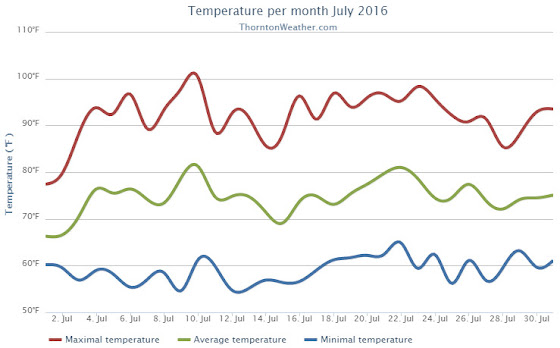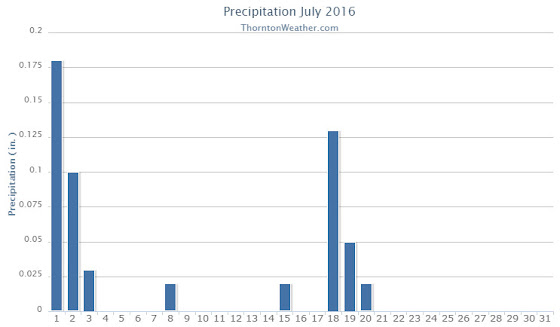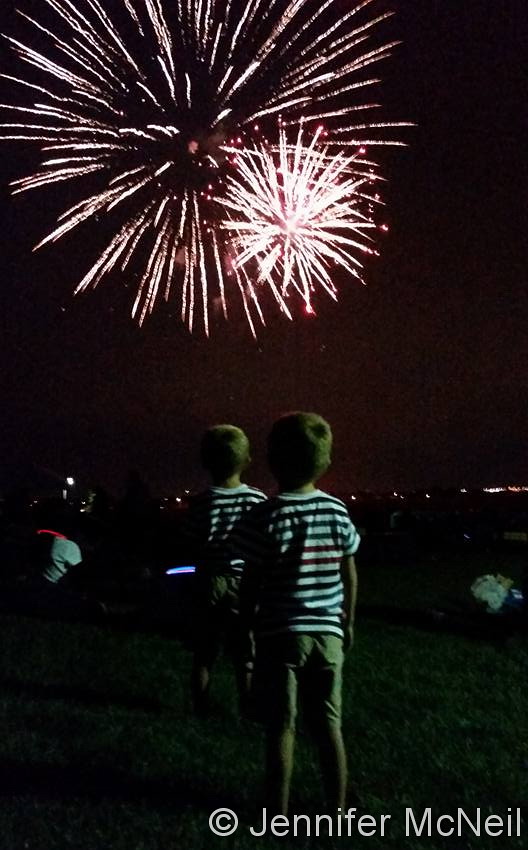
Our weekly look back at Denver weather history always has interesting items but this week one stands out in particular. Denver has never officially recorded snow during the month of July. However, before official records began in 1882, the U.S. Army Signal Service weather observer reported snow on July 17, 1872!
From the National Weather Service:
7-25
In 1934…a streak of 15 consecutive days of 90 degrees ranked 5th on the list of hot streaks. The record of 24 consecutive days was established in the summer of 2008.
13-5
In 2008…a streak of 24 consecutive days of 90 degrees shattered the previous record of 18 consecutive days established in 1901 and 1874. Ironically…no new single day record high temperatures were set in the month of July. In August however…a record of 104 degrees was set on the 1st…and another record of 103 degrees was set on the 2nd. In addition…a record low min of 70 degrees was set on August 2nd.
15-16
In 2006…a brief mid July hot spell resulted in two 100 plus degree high temperatures and two daily maximum temperature records. The high temperature climbed to 101 degrees on the 15th and 103 degrees on the 16th at Denver International Airport.
16
In 1911…thunderstorm winds were sustained to 44 mph from the northwest.
In 1959…a thunderstorm produced 3/8 inch diameter hail and a wind gust to 60 mph at Stapleton Airport.
In 1972…two tornadoes were sighted by the public to the southeast of Aurora. No damage was reported.
In 1978…a thunderstorm wind gust to 52 mph was recorded at Stapleton International Airport.
In 1980…a severe thunderstorm ripped through metro Denver… Producing torrential rain…large hail…and strong winds. In Aurora…winds gusted to 65 mph with hail up to 1 1/2 inches in diameter and half an inch of rain in just 10 minutes. Stapleton International Airport was closed for an hour. Large hail also fell in southeast Denver…Lakewood…Parker… And Castle Rock. Up to 1 1/2 inches of rain fell in just 40 minutes. Heavy rains in wheat ridge flooded a shopping center…breaking windows and doors…while causing 100 thousand dollars in damage. Some roofs and windows were damaged throughout metro Denver. At Stapleton International Airport where west winds gusted to 49 mph…1/4 inch hail and 0.77 inch of rain fell.
In 1983…severe thunderstorms dumped large hail over much of metro Denver. Hail to 3/4 inch in diameter fell in Littleton and Northglenn…with 3/4 to 1 inch hail in Arvada…1 to 1 1/2 inch hail in extreme northwest Denver…1 3/4 inch hail in Lakewood…1 1/2 inch hail in south Arvada and just northeast of Aurora…and 1 5/8 inch hail on Green Mountain.
In 1994…spotters reported a brief tornado touchdown in an open field just north of Fort Lupton. No damage or injuries were reported.
In 2000…very moist and unstable weather conditions…along with low level upslope flow during the late afternoon and evening…combined to produce heavy thunderstorm rainfall… Which caused urban and small stream flooding across metro Denver. Rainfall amounts generally ranged from 1 to 3 inches with the heaviest rainfall occurring during the evening hours. Two miles east of white ranch in northern Jefferson County… An automated rain gage measured 3.86 inches of rain. Since the rain fell in a relatively open area…no flood damage was reported. However…in greenwood village near the intersection of Peoria and Belleview…the streets were closed for several hours with as much as 2 feet of standing water covering the roadways. Two campers near Mt. Evans were injured by lightning and stranded overnight by the inclement weather. Both received minor injuries.
In 2003…the high temperature of 101 degrees was a record maximum temperature for the date.
In 2004…locally heavy rainfall of unknown amount caused parts of the Virginia Canyon Road near Idaho Springs to wash out. The road had to be closed temporarily.
In 2005…the temperature climbed to a high of 102 degrees at Denver International Airport. This was a new record maximum temperature for the date at the time.
16-18
In 1997…an extended hot spell resulted in 3 temperature records being set. The maximum temperature reached 98 degrees on each of the days…setting records on the 16th and 18th. The low temperature of 71 degrees on the 17th was a record high minimum for the date. The high temperature reached 100 degrees on the 17th at the site of the former Stapleton International Airport.
17
In 1872…the U.S. Army Signal Service weather observer recorded snowfall during the early morning hours in the hand written daily weather journal: “rain commenced at 1:30 a.m. changing about 3 a.m. to snow & in about half an hour to rain again; it continued until 6 a.m.” this is the only recorded occurrence of snowfall in Denver in July…but this report is not included in the “official” station snowfall records…which did not begin in Denver until January 1…1882. The low temperature on this morning was 45 degrees…which is sufficiently cold for the occurrence of light stratiform snowfall.
In 1918…a thunderstorm produced hail to an inch in depth on the ground. The stones varied in size from a small cherry stone to nearly 1/2 inch in diameter. Not much permanent damage was done to crops. Precipitation totaled 0.40 inch…and northeast winds were sustained to 25 mph with gusts to 28 mph.
In 1971…the temperature reached a high of 101 degrees at Stapleton International Airport.
In 1983…3/4 inch diameter hail fell at Lafayette…while golf ball size hail pelted Brighton and Northglenn where funnel clouds were also sighted.
In 1986…1 1/2 inches of rain fell in an hour and 15 minutes in southeastern Aurora. Thunderstorm rainfall totaled 0.89 inches at Stapleton International Airport.
In 1987…a small tornado was sighted near Watkins…in the vicinity of Front Range airport.
In 1997…lightning ignited an oil well tank holding 10 thousand gallons of oil…16 miles northwest of Bennett. About 200 acres of grassland burned before the fire could be extinguished. A dry microburst produced a wind gust to 52 mph at Denver International Airport.
In 2000…an estimated 2 inches of rain fell in less than an hour…causing two secondary roads in buck and miller gulches in the hi meadows fire burn area to wash out. Water also covered Jefferson County road 68 which connects to Bailey. Homeowners in pine valley estates attempted to divert some of the runoff by piling stacks of hay on the hillside above their homes. Torrential rainfall…up to 3.50 inches an hour…caused flash flooding along Whiskey Gulch near Elizabeth. Several roads were washed out and basements flooded during the storm. Along County Road 13… About 6 miles north-northwest of Elizabeth…rushing water washed away a 15-foot section of the road. The floodwaters forced debris and mud into four huge culverts…sending water over the road. At Denver International Airport…an United Airlines ground crew worker was struck by lightning as she was loading a Boeing 747 jumbo jet. The woman was injured when lightning either hit the jet or the loading equipment that she was working near. The 25-year-old woman received only minor injuries.
In 2006…outflow from severe thunderstorms to the southeast of metro Denver produced southeast sustained winds to 35 mph with gusts as high as 52 mph at Denver International Airport during the late evening.
In 2011…a deluge of heavy rain occurred in and around Nederland when the storm dumped nearly 2 inches of rain in 30 minutes. The heavy rainfall washed out hillsides and dirt roads. In Nederland…a culvert became blocked with debris and forced the water to spread into a nearby bookstore. The rainfall also damaged several residential roads in the Sunnyside Subdivision and Navajo Road became impassable. Several homes suffered flood damage as the runoff from a nearby Beaver Creek jumped its banks and flooded garages…living rooms and bedrooms of nearby houses.
18
In 1874…the temperature climbed to 90 degrees or more for the 18th consecutive day…setting a record. The record was equaled from July 6th through the 23rd in 1901.
In 1902…a thunderstorm produced northwest winds sustained to 45 mph with gusts to 48 mph along with rain and hail. Total precipitation was 0.53 inch.
In 1911…a shower produced north winds sustained to 44 mph.
In 1958…1 1/2 inch diameter hail fell 9 miles west-southwest of Stapleton Airport.
In 1981…a thunderstorm bombed Evergreen with about 2 inches of rain in 45 minutes. A heavy hailstorm left 5 to 7 inches of hail on the ground in some places and stopped the Colorado Open golf tournament at Hiwan.
In 1985…over 2 inches of rain doused the southwest suburbs of Denver. Street flooding occurred in the Montbello area of northeast Denver.
In 1992…nickel size hail fell across central Douglas County near Castle Rock and Sedalia. One inch diameter hail fell in Castle Rock.
In 1993…thunderstorm winds gusted to 60 mph at Strasburg east of Denver.
In 2004…heavy thunderstorm rainfall caused flooding over parts of the Virginia Canyon Road near Idaho Springs. Several sections of the roadway were washed out. The road was closed temporarily for repairs.
18-19
In 2003…heavy rain producing thunderstorms caused flash flooding across southern metro Denver. Automated rain gages measured 2 to 3 inches of rain in less than an hour. The heavy rainfall caused many intersections and underpasses to flood…stranding motorists. Sections of I-25 and I-225 were closed due to the high water.
18-2
In 1987…a streak of 16 consecutive days of 90 degrees ranked 4th on the list of hot streaks. The record of 24 consecutive days was established in the summer of 2008.
19
In 1875…recent heavy rains produced high waters on many creeks and rivers in the area…which threatened the destruction of property at some locations. Cherry Creek in the city was running the highest in 10 years. Heavy rain in the mining regions over the last 2 days resulted in water running “everywhere” and the suspension of some work.
In 1881…a thunderstorm passing across the city produced lightning with no rain. A woman was seriously injured when struck by lightning several blocks from the weather office in downtown Denver.
In 1934…the temperature reached a high of 100 degrees in downtown Denver.
In 1965…hail…rain…and lightning hit west metro Denver. Hail stones as large as 1 1/2 inches in diameter accumulated to a depth of 2 inches in Evergreen where 2.95 inches of rain in 2 hours caused some flooding in the business section of the town. Lightning caused some power outages.
In 1973…two funnel clouds were observed 5 miles southeast of Littleton. The same funnel clouds were observed for 20 minutes…5 miles west and 5 miles west-southwest of Arapahoe County airport…now centennial airport.
In 1975…lightning injured a man in Denver and caused power outages in Aurora…Lakewood…Westminster…and west Denver.
In 1984…strong thunderstorm winds gusting to 45 mph shattered 7 large plate glass windows at Stapleton International Airport.
In 1985…a tornado touched down in the surrey ridge area of northern Douglas County…just west of I-25. Ten homes were damaged; one under construction was nearly destroyed. Two vehicles were thrown off I-25 injuring three people. A pick-up truck was thrown 50 feet by the twister. In addition…a cluster of severe thunderstorms pounded all of metro Denver with torrential rain…hail…and wind. The heaviest rain fell in Aurora where one location reported 2.37 inches in just 40 minutes. One location in northeast Aurora received a total of 4.30 inches from the storm. There was extensive street and basement flooding…and a number of roads were damaged or washed out. An Aurora boy suffered minor injuries when he was washed into a drainage ditch. Golf ball size hail in Aurora piled up to 5 inches deep. An inch of rain fell in 20 minutes at Stapleton International Airport…closing it to air traffic for an hour. Up to 1 1/2 inches of rain fell in just 15 minutes over central Denver with the high water closing I-25. The water was so deep on the freeway…that one vehicle was completely submerged and people were diving into the water from the freeway overpass. Three homes in Littleton were damaged by lightning. Wind blew out several windows from a high rise apartment building in southeast Denver. Rainfall totaled 1.51 inches at Stapleton International Airport.
In 1997…torrential rain and damaging hail pummeled eastern sections of metro Denver. Hail up to 1.25 inches in diameter fell at the national weather service office on the site of the former Stapleton International Airport. The hail continued for about 15 minutes and accumulated to a depth of 2 to 3 inches…causing extensive damage to cars in the area. Heavy rainfall totaled 3.83 inches in about an hour from the nearly stationary thunderstorm. Numerous cars stalled along I-70…and several homes were flooded in east Denver. The roof of a building collapsed under the weight of the water. The next day several “fatalities” were discovered near the national weather service office; two prairie dogs were found dead along with three rabbits that either drowned or were killed by the large hail.
In 1999…lightning struck two residences in Littleton…but caused only minor damage. Lightning triggered a fire at a residence in cherry hills village. A small portion of the roof and ceiling were damaged before the fire could be extinguished.
In 2000…hail as large as 1.25 inches in diameter fell near roggen northeast of Denver.
In 2004…heavy rainfall caused flooding on the Virginia Canyon Road near Idaho Springs…which had to be closed for repairs.
In 2006…the temperature climbed to a high of 100 degrees. The high temperature was not a record maximum for the date.
In 2007…a severe thunderstorm produced large hail…up to 1 inch in diameter…about 6 miles north of Northglenn.
19-23
In 2005…the high temperature climbed above 100 degrees on each of the 5 days with readings of 101 on the 19th…105 on the 20th…104 on the 21st…and 102 on both the 22nd and 23rd. A new record maximum temperature for the month of July of 105 degrees was set on the 20th…which also equaled the all time record maximum for Denver of 105 degrees first set on August 8th in 1878. Daily maximum temperature records were set on each day…and the 5 day period equaled the record for the most consecutive days of 100 degrees or more first set from July 4th through 8th in 1989. The intense heat resulted in a high use of electricity for cooling purposes. The demand for electric power exceeded the supply and rolling black-outs… Each lasting about an hour…were scheduled across metro Denver during the afternoons and early evenings.
20 Continue reading July 16 to July 22: This week in Denver weather history




